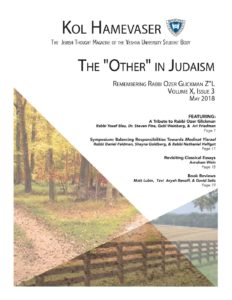Letter from the Editor
My God My God/ May these never end…/The sand and the sea/The rustle of the water/The lightning of the Heavens/The prayer of man (Hannaa Szenes, “Eli, Eli”)
Like the sand and the sea, human prayer is both eternal and ever-changing; it transcends the barriers of time, language, and religion. Some of the earliest texts found by archaeologists are texts of prayer, pointing to the innate inner movement within humanity to respond to the call of the Infinite, and to call out in response. “The soul is in constant state of prayer,” wrote the influential Jewish thinker and leader, Rabbi Abraham Isaac Kook. Similarly, in Tikon Tefilati, Rav Dov Zinger’s book on prayer, he writes, “The call to prayer is the call to life, a call to open ourselves to the fundamental and deep voice whispering within us and within all of reality at all times.” And yet, despite this innate call to prayer, prayer has become an almost taboo topic in our community. When we shared with fellow students that the theme of this issue would be prayer, many students responded with a sense of hesitation and even discomfort: “I just don’t really connect to that topic, but I’d love to write for future topics,” was the response we most commonly received.
This issue of Kol Hamevaser aims to create a space for dialogue about prayer within our community: about the meanings of Jewish liturgy and its laws, but also about the simple, personal, and dynamic ways in which our prayers move us, challenge us, and change us. In this issue, Ilan Lavian examines the Scriptural context of Birkat ha-Kohanim, and how this context changes our understanding of the blessing. Reuven Herzog explores the paradoxical nature of repentance through the story of Jonah, and his prayers. In an article on the Rambam’s Hilkhot Tefillah, Rabbi Shalom Carmy presents an analysis of the necessity of kavvanah in prayer, which has significant implications for the debate surrounding the original purpose of the Brisker method. Similarly, Rabbi Dr. Michael Rosensweig reveals the implications of Maimonides’ terminology in Hilkhot Teshuva by analyzing the talmudic source Maimonides draws from. In a symposium on the challenges of prayer, Dr. Deena Rabinovich, Rabbi Dr. J.J. Schacter, and Rabbi Ezra Schwartz discuss the role of prayer in our community, and how it can be a greater source of meaning in our lives. Finally, in our revisiting classical essays section, David Rubinstein revisits Rabbi Aharon Lichtenstein’s essay “Does Jewish Tradition Maintain an Ethic Independent of Halakha?”, explaining and further exploring its ideas.
We would like to thank the Bernard Revel Graduate School of Jewish Studies and the Yeshiva College Student Association (YCSA) for sponsoring this issue. It is our prayer that the ideas in this publication will reach the hearts and minds of readers, uniting Torah and tefilla, so that words of Torah can serve as words of prayer, and that words of prayer can serve as words of Torah.
Leah Klahr is a junior at Stern College, majoring in English literature and Jewish studies.


